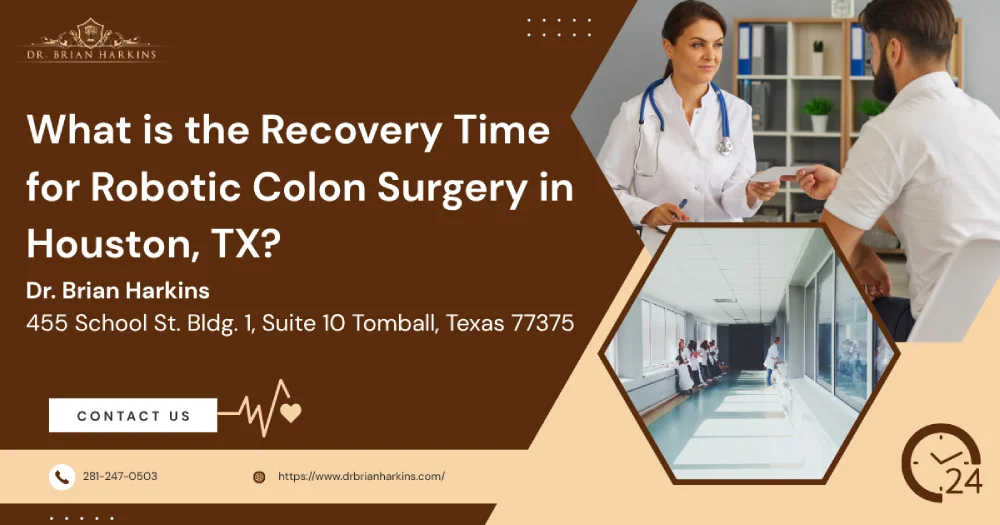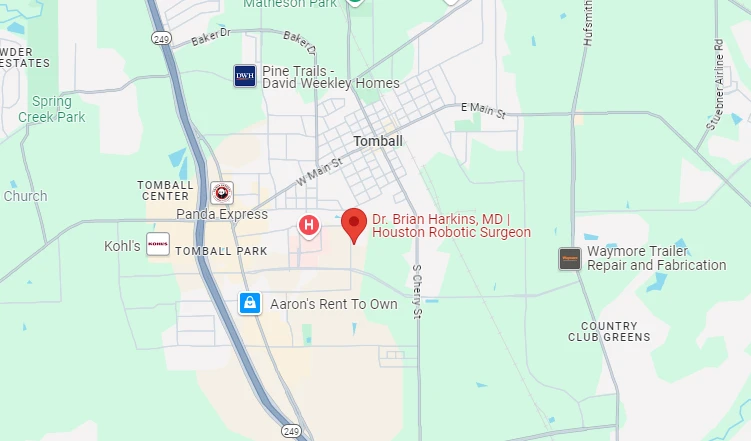
Robotic colon surgery—a minimally invasive type of surgery that many Houston colorectal specialists now favor—has changed the game for patients who need a bowel resection or other colorectal procedures. By merging tiny incisions, high-definition 3-D optics, and a steady robotic arm, the approach shortens hospital stays, trims post-op pain, and leads to a quicker recovery compared to open surgery or even traditional laparoscopic surgery. Complete recovery, including returning to most normal activities, usually takes 2–4 weeks. Your fitness level, the exact surgical procedure used to treat colon or rectal disease, and adherence to Enhanced Recovery After Surgery (ERAS) instructions all influence that timeline.
Robotic surgical technology (often the da Vinci Xi system) allows surgeons to operate through a few half-inch ports instead of a six-inch cut used in traditional open surgery. The high-definition console gives a magnified view of the surgical field, while wristed instruments mimic—but exceed—the motion range of the human hand. This minimally invasive approach means less tissue trauma, minimal blood loss, and faster recovery times for Houston-area patients.
| Day / Week | What You’ll Likely Feel | Activity Level | Nutrition Focus | Doctor Touchpoints |
|---|---|---|---|---|
| Day 0 (Surgery) | Sore but alert within hours | Sit on edge of bed, short walk with nurse | Ice chips → clear liquids | Surgeon rounds before discharge order |
| Days 1–3 | Gas pain, fatigue | 3–6 hallway walks/day | Clear → soft diet | Discharge teaching & home-health plan |
| Week 1 | Mild incision soreness, bloating | Short outdoor walks, no lifting >10 lbs | Low-fiber, high-protein meals | Virtual nurse check-in |
| Week 2 | Energy climbing, bowels regulate | Add light chores | Gradual fiber re-intro | Staple or suture removal |
| Weeks 3–4 | 70–90 % normal energy | Drive, desk work, gentle yoga | Regular balanced diet | Follow-up visit & activity clearance |
Most Houston patients leave the hospital the day after robotic colorectal surgery. The care team tracks pain, urine output, and the first passage of gas—signs your intestines have “woken up.” Once home, set a phone timer to walk every two hours. Multiple short walks stimulate circulation without exhausting you, supporting a smoother recovery.
Your colon remains swollen, so focus on small, low-fiber meals—scrambled eggs, Greek yogurt, or soft fish. Random shoulder pain arises as residual CO₂ from the laparoscopic and robotic surgery dissipates. Keep incisions clean and dry; shower rather than soak unless told otherwise.
By Week 3 many Houstonians with desk jobs are back at work or WFH. Light cardio such as stationary biking is often cleared, but hold off on CrossFit, powerlifting, or contact sports until the surgeon is able to confirm the internal staple lines are solid.
Pre-surgery activity—say, jogging the Memorial Park loop—often predicts a shorter recovery. Chronic conditions like diabetes, COPD, or prior open surgery for colon cancer can lengthen healing.
High-volume cancer programs such as Houston Methodist, MD Anderson, and Memorial Hermann use ERAS pathways, specialized nursing, and advanced robotic systems, leading to faster discharges and lower complication rates versus open surgery.
Houston humidity demands constant hydration after any minimally invasive colorectal surgery. Schedule walks at dawn or dusk to avoid heat stress; consider a temporary ground-floor stay if you live in a high-rise and must avoid heavy door pulls or long elevator waits.
If any of these arise, call your colorectal team or head to a 24/7 emergency center like Houston Methodist ER or CHI St. Luke’s.
Recovering from robotic colon surgery in Houston no longer sidelines patients for months. Most leave the hospital within 48 hours, regain independence by Week 2, and feel 90 % normal by Week 4. Hydrate well, walk often, fuel your body with protein, and respect lifting limits. Stay alert to warning signs and keep scheduled follow-ups. With disciplined self-care and modern robotic surgical techniques, you can swap the recliner for Bayou City life in just a few weeks—often with faster recovery and higher quality of life than open procedures.
No. Both are minimally invasive, but robotic surgery adds a console-controlled robotic arm that holds laparoscopic instruments with wrist-like motion. This extra dexterity helps the surgeon dissect around blood vessels or nerves more precisely, which is especially valuable in tight pelvic spaces during rectal cancer operations.
Patients who undergo robotic or laparoscopic procedures typically experience less postoperative pain, lower infection rates, and a quicker return to normal activities. Hospital stays average one to two nights versus four to seven nights for open surgery, and most people resume desk work within three to four weeks.
Yes, robotic technology is flexible enough for right-, left-, and sigmoid-colon resections, plus low rectal surgery. However, extremely large tumors or widespread disease may still require an open approach. Your colorectal surgeon will weigh tumor size, location, and your overall health before selecting the safest technique.
Only certain low rectal or emergency procedures require a protective ostomy. Modern robotic precision and better vascular control often allow surgeons to preserve bowel continuity in straightforward colon cancer surgery. Your surgeon will explain personal risk factors and whether a stoma is recommended for healing.
The robot never acts on its own. Throughout the operation, the surgeon operates the console to control each robotic arm. Tasks include precise cutting, cauterizing small vessels, suturing, and docking additional ports. Real-time 3-D imaging lets the surgeon see tissue layers magnified, enhancing every move.
High BMI, advanced age, or scar tissue from prior open surgery can make any minimally invasive procedure more complex, but they are not automatic disqualifiers. Experienced Houston surgeons use pre-operative imaging and ERAS preparation to determine whether a laparoscopic or robotic approach remains safe.
Light stationary cycling or gentle yoga is often allowed by Week 3, but anything that strains core muscles—like heavy lifting or aggressive Pilates—must wait four to six weeks. Clearance depends on how the surgical site looks at follow-up and how quickly internal staples anchor securely.
Most major insurers, including Medicare, cover robotic colorectal surgery when it is medically necessary for colon or rectal cancer, diverticulitis, or inflammatory bowel disease. Always verify with your plan and hospital billing team, because deductible levels and robotic technology fees vary by policy.
Enhanced recovery pathways coordinate anesthesia, pain management, nutrition, and early mobilization protocols. Data show these multidisciplinary protocols shorten hospital stays, reduce complications, and speed digestive recovery. Houston hospitals generally include carbohydrate drinks before the procedure and early oral intake afterward as part of these pathways.
Pathology findings—not the surgical approach—determine whether adjuvant chemotherapy or radiation is needed. Factors include tumor stage, lymph-node involvement, and margin status. Even with clear robotic margins, stage III colon cancer typically receives chemotherapy to lower recurrence risk. Your oncology team will guide post-operative treatment plans.


Dr. Brian Harkins is a renowned surgeon specializing in advanced, minimally invasive, and robotic surgical techniques. With a dedication to innovation and personalized patient care, he has transformed countless lives by delivering exceptional outcomes.

I want a website like this, where do i start?